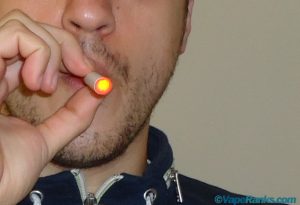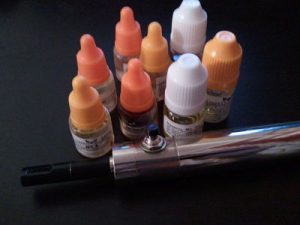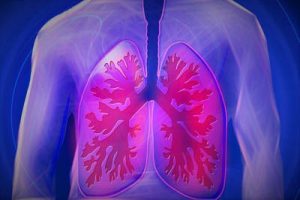Swiss Study Finds E-Cigarette Suitable for Therapeutic Administration of Medical Marijuana
Inspired by the illegal practice of dabbing of butane hashish oil (BHO), a team of Swiss researchers recently published a scientific study on the efficiency of “cannavaping” – the vaping of e-lliquid enriched with cannabinoids, including BHO. They found e-cigarettes were a great alternative to smoking marijuana or taking cannabinoid pills.
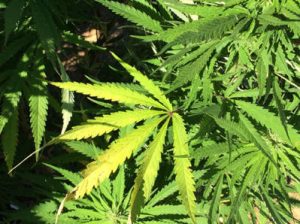 According to the research published in the Scientific Reports journal, “dabbing involves vaporizing cannabis concentrates (BHO or cannabis dabs) at 300–400 °C on a hot surface and then inhaling the vapor through a specialized pipe. After thermal treatment, inactive tetrahydrocannabinolic acid (THC-A) is decarboxylated into psychoactive tetrahydrocannabinol (THC). BHO is highly enriched in THC, and its concentration is typically 15 to 30 times higher than that found in flower buds.”
According to the research published in the Scientific Reports journal, “dabbing involves vaporizing cannabis concentrates (BHO or cannabis dabs) at 300–400 °C on a hot surface and then inhaling the vapor through a specialized pipe. After thermal treatment, inactive tetrahydrocannabinolic acid (THC-A) is decarboxylated into psychoactive tetrahydrocannabinol (THC). BHO is highly enriched in THC, and its concentration is typically 15 to 30 times higher than that found in flower buds.”
“Commonly, a dab of the dense oil is placed on the end of a glass or titanium rod that has been heated. If the dab has been previously decarboxylated, the flame from a lighter is sufficient to vaporize the BHO, but if the dab has not been decarboxylated, a blowtorch is used to maximize the decarboxylation of THC-A into its psychoactive form, THC, and to vaporize the BHO concentrate.” That sounds very different than vaping, but only if you’re not familiar with a thing called direct dripping, where e-liquid is dripped directly onto the atomizer coils and is absorbed by a wicking that comes in direct contact with the heated metal.
Intrigued by the creativity of cannabis users who came up with this alternative way of cannabinoid delivery, and knowing that e-cigarette technology was at least theoretically compatible, researchers set out to evaluate the efficiency of cannabis vaping using commercially available e-cigarettes as an alternative to marijuana smoking for therapeutic cannabis delivery.
In their experiments, scientists found that just like with normal vaping, the e-cigarette settings have to be tweaked in order to generate the greatest amount of aerosol and THC and fewer toxic by-products. Overly high power can damage the coil and lead to the formation of toxic compounds. If you’re been using advanced mods and building your own atomizer coils, you’re probably familiar with concepts like atomizer resistance and battery voltage. They apparently went with 3.8Ω resistance and a 5V battery, which created a constant power output of 6.4W.
The temperature registered in the vicinity of the coils was 165 °C on average. Researchers noted that the temperature would have likely risen higher in longer puffs, but would have met the conditions of what is known as a dry puff. Though lower than the temperatures reached during recreational cannabis dabbing, 165 °C were found to be sufficient to promote full decarboxylation.
“The solubilization of crude, not unheated, BHO was difficult because of the presence of insoluble matter and fine plant fragments and impurities,” scientists mention, pointing out that using commercial propylene glycol and vegetable glycerin liquids prevents the manufacture of liquid refills with high BHO concentrations preferred by recreational users of cannabis in order to feel its intense psychoactive effects.
Concerning the concentration of carbonyls and volatile organic compounds (VOC) in the vapor generated by e-cigarettes, the study found only two carbonyls in significant amounts (formaldehyde and acetaldehyde) and only propylene glycol as VOC. Scientists found a direct correlation between the e-cigarette settings and the concentrations of carbonyls: 6.6 W of heating power resulted in a minimal vaporizing coil temperature of 165 °C. “Under these conditions, the carbonyls amounts reported herein were less than those reported in other studies with a cumulated carbonyls quantity of 380 μg, generated by 10 successive puffs (voltage: 5 V)”
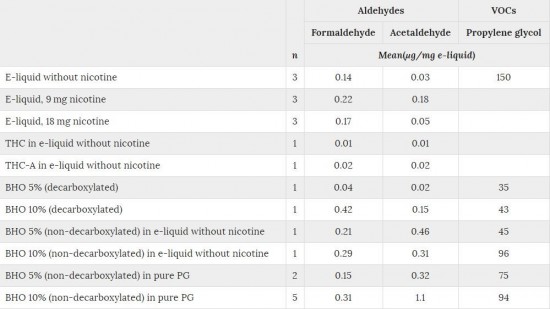
Carbonyls and VOCs concentrations
These findings confirmed that “vaporization conducted at less than combustion temperatures is one of the best recommended alternative methods to cannabis smoking. A vaporizer heats the cannabis plant material at a moderate temperature, causing the active cannabinoids to evaporate into an aerosol that contains far fewer harmful components.” The problem was achieving a homogenous and stable mixture of high-potency waxy residues of cannabis extracts. Researchers could obtain BHO concentrations of up to 10% inVG and PG e-liquids, which is not enough for medical use. To put that into perspective, inhalation of approximately 100 puffs of 70 ml of this e-liquid would have been necessary to induce the same effects than those caused by intravenous THC administration of 1.5 mg. Thus, solubility optimization research, in particular with PG, is recommended.
There is however a bright side to this low BOH concentration in commercial e-liquid. “Concerning misuse of cannavaping, the high number of puffs required to induce minimal psychoactive effects could be considered a rebuttal to cannavapers who wish to experience the same effects as real cannabis cigarettes with e-cigarette. To feel the first psychoactive effects sooner, increases in BHO levels and THC concentrations in the vaped solution are required, but due to the inconvenience in its manufacture and final organoleptic properties, such goals will be made more difficult and less appealing,” the Swiss scientist concluded. “In our opinion and according to other scientists, recreational cannavaping remains possible with e-cigarettes; however, its poor efficiency makes the risk of observing a new recreational cannavaping trend unlikely.”
Thus, therapeutic cannavaping might be the most interesting outcome for the cannabinoids use with e-cigarettes, in the opinion of the study authors. They feel that this gentle method of THC delivery could be of great importance in the context of finding new administration methods for medical cannabis. It makes it possible to avoid inhaling large amounts of toxic substances released during the combustion of regular cannabis, and guarantees soft and reproducible THC delivery if the spiked liquid refill composition is controlled.
“Cannavaping could also be recommended to patients who want to quit cannabis smoking or to reduce significantly the importance and frequency of their consumption and possibly attenuate withdrawal symptoms,” the study claims.
The one fear researchers have about using advanced e-cigarettes with BHO-spiked e-liquid has to do with the adjustable settings of the devices. Users may opt for unsafe settings can be selected to increase the efficiency of BHO and THC vaporization, which in turn may lead to the formation of high amounts of carbonyls like formaldehyde and acetaldehyde. “It is therefore important to monitor carbonyls and VOCs contaminants to keep these potentially toxic residues in negligible quantities,” they recommend.
In conclusion, the Swiss study authors wrote that “Cannavaping appears to be a gentle, efficient, user-friendly and safe alternative method for cannabis smoking for medical cannabis delivery. Its expected benefits very likely overcome the advantages of oral administration because ingestion is characterized by its erratic absorption and poor biodisponibility. Ingested compounds that undergo first pass metabolism could be less active than inhaled compounds, which would have direct access to the bloodstream without being metabolized first. Moreover, cannavaping could avoid emesis due to strong doses of therapeutic cannabinoids when smoked or inhaled through vaporization.”
“Recreational or addictive cannavaping is theoretically possible. However, the poor solubility of BHO in commercial liquid refills (especially those with high glycerin content) prevents achieving high BHO concentrations, which are very likely preferred by recreational cannavapers and dabbing consumers. Illegal cannavaping is suspected to present a low risk of becoming popular among cannabis smokers.”

